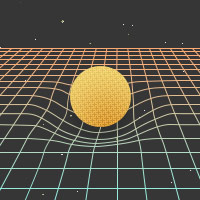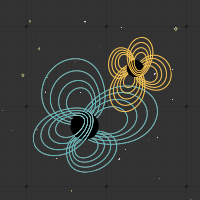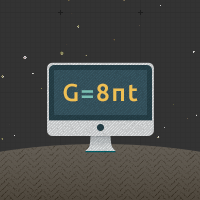Einstein's Point of View
The Struggle Lost, Einstein Pushes Further
We've seen that changing our viewpoint in the Solar System might make certain problems simpler, but won't have anything to do with how the Solar System behaves. This change of perspective is just a change of position. In trying to solve an enormous problem in physics, Einstein found another type of viewpoint which makes no difference to Nature: speed. It doesn't matter how fast you're going; the laws of physics should be the same.
At the dawning of the twentieth century, physicists found themselves in a state of general confusion. James Clerk Maxwell had devised a set of equations which beautifully and simply accounted for all of electricity and magnetism. His equations even showed that light was a type of "electromagnetic" wave. They predicted how light would bend going through a lens or a prism; how it would bounce off of metals; even how fast it would move.
Most importantly, Maxwell's equations predicted just one speed for light, which we now measure to be about 670,616,629 miles per hour (or exactly 299,792,458 meters per second). This brings up an interesting question, though. Speed is measured by comparing something that is moving to something that is standing still. What is chosen as the thing that is standing still?
We could try to make an arbitrary choice for that one thing standing still: someone standing on a particular spot in Greenwich, England, for example. But then, anyone in the Antipodes Islands of New Zealand — the opposite side of the globe — would be going in a different direction because the Earth is spinning. Now, to a physicist at the time, this meant that the person in New Zealand would measure a different speed of light than the person in England.
The problem is that Maxwell's equations only predict one particular speed of light, and make no mention of any special point on Earth. There is no reason they should be correct for someone in England, but not for someone in New Zealand. We could pick the center of the Earth, or the center of the Sun, or anywhere else, and run into the same problem. Physicists believed that the Universe must have some definite standard of standing still. The problem was that they had trouble finding it.
Scientists Albert Michelson and Edward Morley invented a clever experiment to detect changes in the speed of light with amazing accuracy. If their device was moving at all compared to the Universe's standard of rest, the device should be "catching up" with the light moving in the direction of motion. They could then change the direction the light was traveling, which would have changed its speed in the device. No matter how they moved their device, however, they didn't see any change in the speed of light.
It is important to understand the significance of this discovery. Imagine one astronaut floating in space. She sends out a flash of light, and measures its speed to be 670,616,629 miles per hour. Now imagine that another astronaut zooms past, going 670,616,628 miles per hour in the same direction as the light. Shouldn't he measure the speed of light to be just one mile per hour? Moreover, couldn't the second astronaut go just a few miles per hour faster, and pass the light? Maxwell, Michelson and Morley seemed to be answering that both astronauts see the light moving forward at 670,616,629 miles per hour, no matter what!
Many theoretical physicists rejected this, and came up will all sorts of ideas to explain the experiment's results, but none really succeeded as a scientific theory. Einstein took a different approach. He realized that speed is just another example of "viewpoint," like position in the Solar System. Just as Nature won't care where we are, Nature won't care how fast one astronaut is moving compared to another. Einstein decided to write down equations of physics that were true, no matter where he was or how fast he was going; they must make no reference to any special place or speed. Of course, it turns out that Maxwell's equations are just like this, and they predict only one speed of light.
Most physicists had a difficult time accepting either of these facts — that different viewpoints should be treated equally, or that everyone would measure the speed of light to be the same. Einstein used both facts as the twin pillars of his revolutionary theory of spacetime. To understand this surprising theory, we have to think more carefully about what we mean by space and time.






